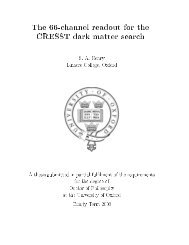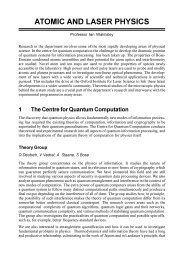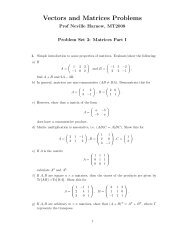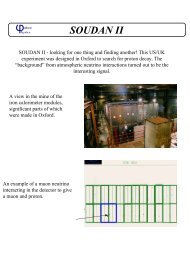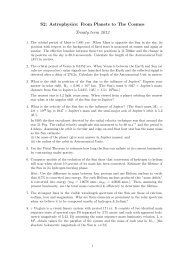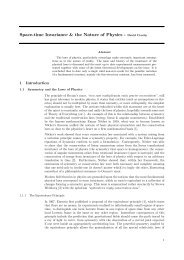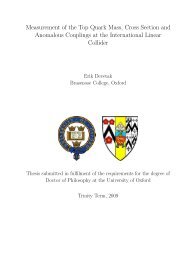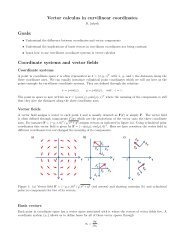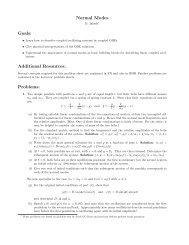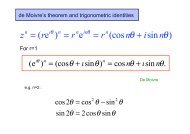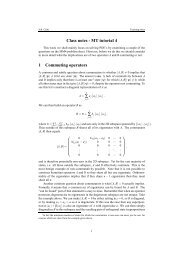Create successful ePaper yourself
Turn your PDF publications into a flip-book with our unique Google optimized e-Paper software.
Environmental Impact <strong>of</strong> Nuclear Power<br />
Nuclear Fuel Cycle for typical reactor<br />
Uranium<br />
mining,<br />
milling and<br />
concentration<br />
Final<br />
disposaldeep<br />
geological<br />
depository)<br />
4200tU as<br />
enriched U 3 O 8<br />
24t HLW<br />
100m 3<br />
600tU<br />
in used<br />
fuel<br />
900m 3 in<br />
containers<br />
Conversion<br />
to UF 6<br />
(gas)<br />
Reprocessing<br />
and vitrification<br />
<strong>of</strong> HLW<br />
Interim storage<br />
option (20 yrs +)<br />
4200tU as<br />
enriched UF 6<br />
1<br />
600tU<br />
in used<br />
fuel<br />
2<br />
Enrichment<br />
to 3.5%<br />
235<br />
U<br />
Reactor<br />
Operation<br />
1000 MW<br />
30 years<br />
operation<br />
10,000 m 3 waste<br />
(operating and<br />
decommissioning)<br />
600tU as<br />
enriched<br />
UF 6<br />
Fuel<br />
fabrication<br />
as UO 2<br />
600tU as fresh UO 2 fuel<br />
200 10 9 kWh <strong>of</strong><br />
electricity<br />
equivalent to<br />
17.10 6 tonnes <strong>of</strong> oil<br />
Categories <strong>of</strong> Nuclear Waste<br />
1. LLW(Low Level Waste) ~89% <strong>of</strong> total volume<br />
Low radioactivity, negligible long-lived activity (rags, tools, filters,<br />
etc, from hospitals, research labs and nuclear power stations<br />
2. ILW (Intermediate Level Waste) ~11% <strong>of</strong> total volume<br />
Requires shielding, contains some long-lived activity (resins, sludges,<br />
Fuel cladding) can be set in concrete/bitumen<br />
3. HLW (High Level Waste) ~0.3% <strong>of</strong> total volume<br />
Highly active, heat generating, long-lived activity requires vitrification<br />
and long-term storage<br />
National Waste Disposal Programmes<br />
France: 400,000 m 3 <strong>of</strong> short-lived waste in shallow land burial at<br />
La Manche site<br />
Investigating sites for deep disposal <strong>of</strong> long-lived waste (including<br />
vitrified HLW) from 2015<br />
Germany :LLW and ILW in former salt mine<br />
Investigations <strong>of</strong> Gorleben salt dome for final disposal <strong>of</strong> vitrified HLW<br />
Japan: LLW put in shallow burial site (200,000m 3 capacity). HLW being<br />
vitrified and stored for 30-50 years until suitable deep repository found<br />
UK: Underground repository for LLW/ILW at Sellafield. HHW vitrified<br />
stored 50 years at Sellafield before eventual disposal in deep repository<br />
USA: Three LLW sites. National HLW site Yucca Mountain (?) (Nevada)<br />
Outstanding Issues<br />
• Deep repositories required to keep HLW intact for 10,000 years<br />
Geological stability and <strong>water</strong> ingress are uncertain<br />
• Long-term stability <strong>of</strong> vitrified waste unknown<br />
• Public unease- easy target for anti-nuclear lobby<br />
• Moral issue- should we burden future generations with our waste?<br />
Counter argument: they will also need to dispose <strong>of</strong> nuclear waste, so<br />
we are solving the technical problems for them. Also danger from<br />
not reducing CO 2<br />
Nuclear<br />
Power<br />
Chernobyl




